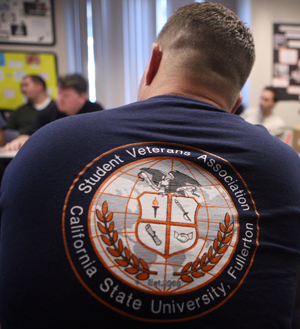Easing the Path of Re-Entry
Student Veterans Get Help Navigating Back to School
SCOTT THOMPSON, president of Cal State Fullerton's Student Veterans' Association (SVA) chuckles when he recalls a Veteran's Day parade last year where a certain section of the parade route was reserved for veterans.
“We had a group from SVA that was participating so many of our student veterans sat down,” he recalled. “One of the organizers came over and very politely asked them to leave, saying, 'I'm sorry but this area is reserved for veterans.' Our group just looked at her and said, "Ma'am, we are veterans.' Of course, the woman was very apologetic but, I think that many people have the idea that veterans are older — not in their 20s. With the wars in the Middle East, we see younger and younger veterans and, after serving, many want to go to college.”
Returning to or starting college after years in the military isn't always easy, Thompson said.
“In the military, you're told what to do,” he said. “That happens here, too, but there's much more free choice. Add to that the fact that many veterans are also working full-time and supporting families, some are suffering from PTSD (post-traumatic stress disorders), and some find it difficult to work through the bureaucracy of filing forms or even knowing what programs they're eligible for. It can become overwhelming.”
Thompson, a senior majoring in history hopes to become a science teacher. This spring, he will begin work on his single subject teaching credential.
In the early 1980s, he served as a Marine Corps Lance Corporal at Camp Pendleton. He was responsible for maintenance management of all combat equipment — vehicles, guns, communications gear and more.
“I'm a little older than many of our veterans,” he said. “Being a peacetime veteran is different than being a wartime vet. I never had to learn about the woes of the VA system or deal with multiple combat wounds. But, getting to know these vets really inspires me. They are so brave and they've raised my awareness.”
Two of the main goals of SVA are to provide camaraderie and advocacy on behalf of veterans.
“This is a safe place for many to express concerns,” Thompson said. “As far as advocacy, we're here to educate about the different programs and benefits in place. Recently, the VA decided that in order for veterans to receive their full educational benefits/stipends, they need to take a minimum of 12 units instead of nine. That might not seem like a big deal but, if you're suffering from PTSD or have a family to support and a full-time job, that's huge. We voice our concerns to elected officials but also want to make university officials know about these changes.”
The SVA has launched a new mentoring program where a veteran who has attended Cal State Fullerton for at least three semesters works with a newly admitted vet. The mentors explain the services and offer tours of the campus.
The group presently has about 80 members. It meets every Thursday at 4 p.m. in Room 205 of University Hall. All veteran students and their family members are welcome. For more information, visit www.fullerton.edu/veterans/sva.
November 9, 2011
 The Student Veterans Association meets every Thursday at 4 p.m. in Room 205 of University Hall. Photo by Greg Andersen
The Student Veterans Association meets every Thursday at 4 p.m. in Room 205 of University Hall. Photo by Greg Andersen